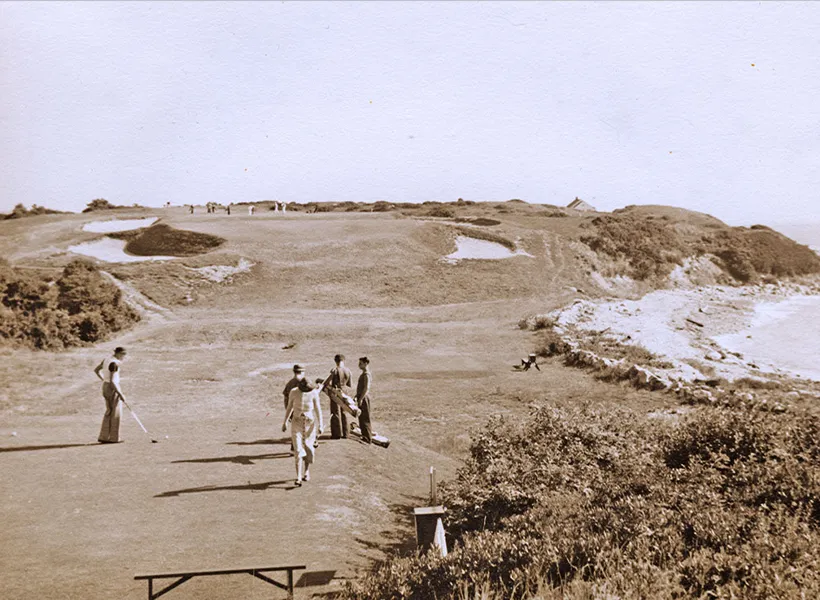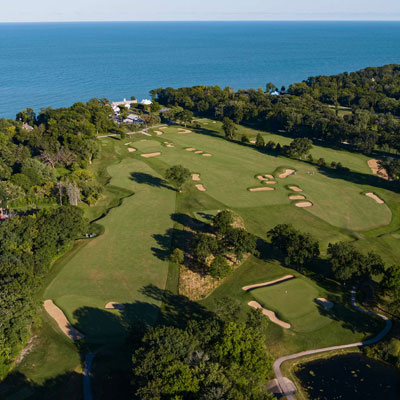Seth Raynor
A Princeton-educated engineer who surveyed the land for C.B. Macdonald's National Golf Links of America and went on to create Fishers Island, Chicago, Yale, and Shoreacres, all featuring geometric styling, deep bunkers, and bold template holes.

May 7, 1874, Manorville, New York
January 23, 1926, West Palm Beach, Florida
A Raynor for the People: Rock Spring
Golf Architecture 101: Template Holes
Charleston Muni: Raynor Revival
When Seth Raynor was hired by Charles Blair Macdonald to survey the site that would become the National Golf Links of America, he “scarcely knew a golf ball from a tennis ball,” according to Macdonald. A native of Long Island, he had studied civil engineering at Princeton without receiving a degree, and set up a landscape engineering and survey firm in downtown Southampton.
Raynor began work with Macdonald at NGLA in 1908, and adapted well to the sport that was brand new to him. Macdonald developed a deep respect for Raynor’s adeptness in surveying, construction, and, eventually, architecture. Macdonald continued to employ Raynor’s services on his next projects, including but not limited to Piping Rock Club (1912), St. Louis Country Club (1914), and The Lido (1918). As time went on, Raynor was given an increasingly important role in Macdonald’s commissions; at the Yale project (1924), Macdonald’s role was just as an advisor.
Raynor also began working on original design projects in 1914. Having learned the principles of golf from Macdonald, he set about being an exponent of Macdonald’s philosophy of “ideal holes” in his solo work. Frequently enlisting the help of Ralph Barton and Charles “Steam Shovel” Banks, Raynor created an extensive portfolio of golf courses for elite clients, in a variety of locations and on a mixture of property types. Raynor designs that remain mostly intact today include Southampton Country Club (1926), Shoreacres (1919), and Yeamans Hall Club (1925). Raynor’s firm was prolific, designing almost 90 courses in just over a decade. This meant that he and his associates traveled extensively, primarily around the Eastern United States, but also further afield, to places like the Twin Cities and Bermuda (with Macdonald).
Eventually, Raynor’s travels caught up with him. After traveling to California (to lay out the original Dunes course at Monterey Peninsula Country Club), Hawaii (to plan Waialae Country Club and Mid-Pacific Country Club), and then back to Florida, Raynor fell sick with pneumonia, and succumbed to the illness in early 1926. He left behind many plans for unrealized projects, 10 of which were completed by Charles Banks, notably Fishers Island Club (1926) and Essex County Country Club (1926).
A reserved and humble man, Raynor is known more for his courses than as a person. In fact, much of what we know about him comes from his mentor, Macdonald.
Chicago Golf Club
Chicago Golf Club is one of the most intelligently designed courses in America, featuring a world-class set of Seth Raynor green complexes
Chicago Golf Club
Fishers Island Club
Seth Raynor's penultimate design, Fishers Island featues bold versions of his "ideal holes" alongside spectacular views of the Long Island Sound
Fishers Island Club
Southampton Golf Club
Seth Raynor's 1925 design provided local access to golf for those unable to join Shinnecock Hills or National Golf Links of America.
Southampton Golf Club
The Yale Golf Course
One of the most audacious feats of 1920s golf architecture, Seth Raynor's Yale Golf Course manages its severe property brilliantly
The Yale Golf Course
Shoreacres
A museum piece on a unique plot of land in the historic golf town of Chicago and one of the finest examples of Seth Raynor’s work
Shoreacres


Leave a comment or start a discussion
Engage in our content with thousands of other Fried Egg Golf Members
Engage in our content with thousands of other Fried Egg Golf Members
Get full access to exclusive benefits from Fried Egg Golf
- Member-only content
- Community discussions forums
- Member-only experiences and early access to events
























.jpeg)








Leave a comment or start a discussion
Lorem ipsum dolor sit amet, consectetur adipiscing elit. Suspendisse varius enim in eros elementum tristique. Duis cursus, mi quis viverra ornare, eros dolor interdum nulla, ut commodo diam libero vitae erat. Aenean faucibus nibh et justo cursus id rutrum lorem imperdiet. Nunc ut sem vitae risus tristique posuere. uis cursus, mi quis viverra ornare, eros dolor interdum nulla, ut commodo diam libero vitae erat. Aenean faucibus nibh et justo cursus id rutrum lorem imperdiet. Nunc ut sem vitae risus tristique posuere.